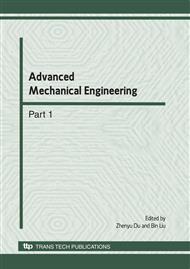[1]
S. Dowlatshahi. Product design in a concurrent engineering environments an optimisation approach, Journal of Production Research, 30(8), pp.1803-1818. (1992).
Google Scholar
[2]
Y. Asiedu and P. Gu, Product Life-cycle Cost Analysis: State of the Art Review, International Journal of Production Research, vol. 36, pp.883-908. (1998).
DOI: 10.1080/002075498193444
Google Scholar
[3]
S. Lim. and I. B. H. Lee, A multiple domain feature mapping: a methodology based on deep models of features, Journal of Intelligent Manufacturing, pp.9-15. (1995).
Google Scholar
[4]
C. Xiao-chuan and F. Ming-lun, Application of Multiple Domain Feature Mapping in Design For Cost(DFC), presented at 9th ISPE International Conference on Concurrent Engineering: Research and Applications (CE2002), Cranfield University, U.K. (2002).
Google Scholar
[5]
G. Pahl and W. Beitz, Engineering Design - A Systematic Approach, second ed. London: Springer. (1996).
Google Scholar
[6]
N. P. Suh, Complexity: Theory and Applications. New York: Oxford University Press. (2005).
Google Scholar
[7]
J. R. Dixon and C. Poli, Engineering Design and Design for Manufacturing - A Structured Approach. Conway: Field Stone Publishers. (1995).
Google Scholar
[8]
R. B. Stone and K. L. Wood, Development of a Functional Basis for Design, Journal of Mechanical Design, vol. 122, pp.359-370. (2000).
Google Scholar
[9]
J. Hirtz, R. B. Stone, D. A. McAdams, S. Szykman, and K. L. Wood, A Functional Basis for Engineering Design: Reconciling and Evolving Previous Efforts, NIST Technical Note 1447. (2002).
DOI: 10.1007/s00163-001-0008-3
Google Scholar
[10]
K. Khadke and J. K. Gershenson, Design Framework for Assessing and Managing Planned Technology Change, Journal of Engineering Design (JED), in press.
Google Scholar
[11]
M. F. Ashby, Materials Selection in Mechanical Design, 2ed. ed. Oxford: Butterworth-Heinemann. (1999).
Google Scholar
[12]
R. L. Norton, Machine Design - An Integrated Approach. London: Prentice-Hall. (1998).
Google Scholar
[13]
K. W. Chase, J. Gao, and S. P. Magleby, General 2-D Tolerance Analysis of Mechanical Assemblies with Small Kinematic Adjustments, Journal of Design and Manufacturing, vol. 5. (1995).
Google Scholar
[14]
A. A. N. S. Institute), Dimensioning and Tolerancing, ANSI Y14. 5M - 1982. New York: American Society of Mechanical Engineers (ASME). (1982).
Google Scholar
[15]
C.M. Creveling, Tolerance Design: A Handbook for Developing Optional Specifications. Massachusetts Harlow: Addison-Wesley. (1997).
Google Scholar
[16]
L. W. Foster, GEO-METRICS II: Addison-Wesley. (1992).
Google Scholar
[17]
P. Krus, An Information Theoretical Perspective On Performance, Refinement and Cost, presented at ASME 2005 International Design Engineering Technical Conferences & Computers and Information in Engineering Conference, Long Beach, California USA, (2005).
Google Scholar
[18]
Information on http: /gicl. cs. drexel. edu/wiki/Group_10_-_Kodak_Flash_Camera.
Google Scholar
[19]
Information on http: /gicl. cs. drexel. edu/wiki/Kodak_Waterproof_Disposable_Camera Appendix Relationships matrixes of Kodak single-use cameras.
Google Scholar


